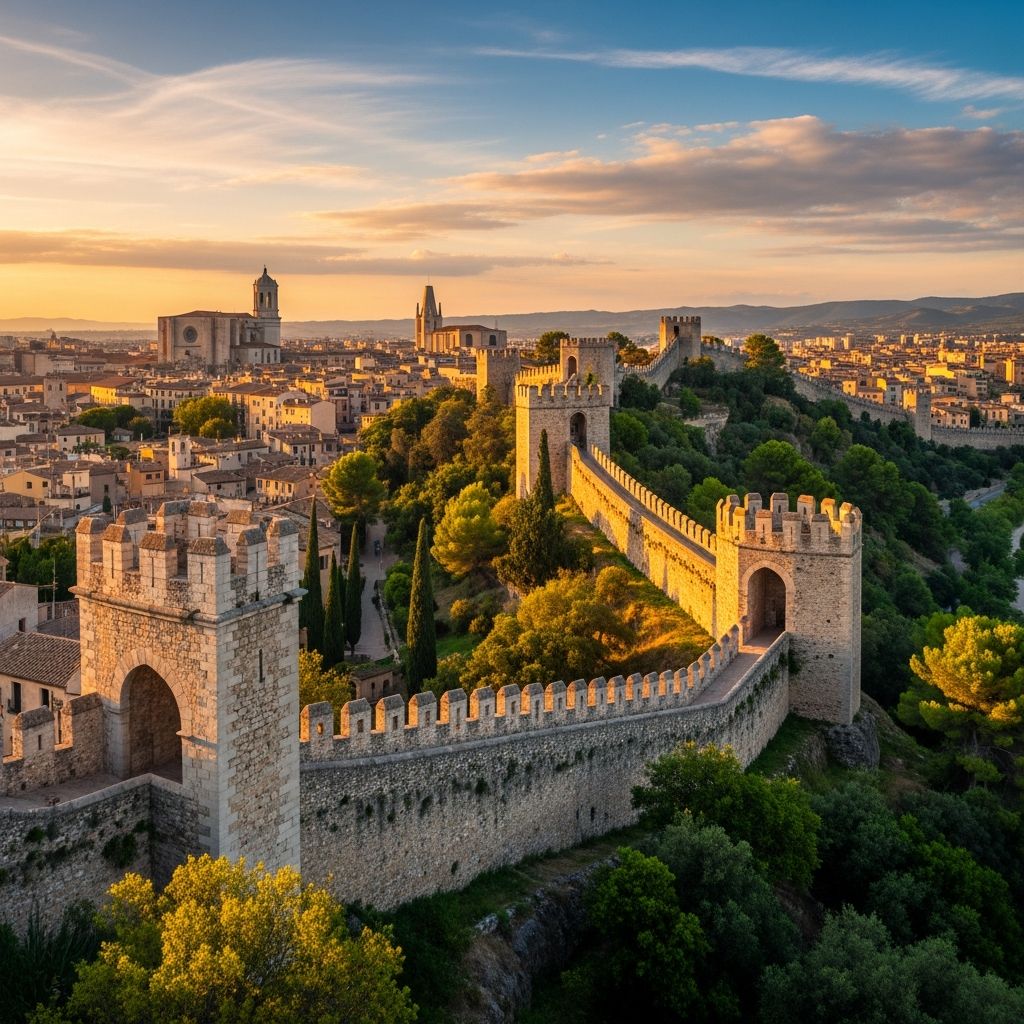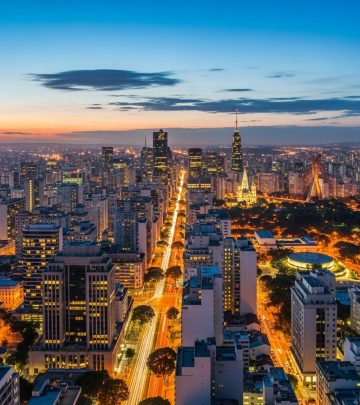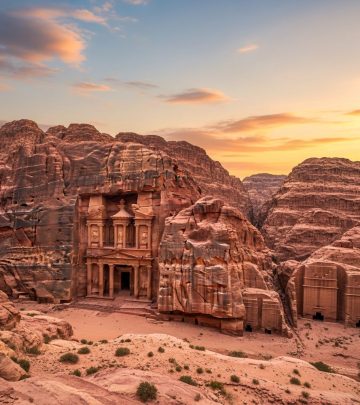Muralles de Girona: Exploring Girona’s Ancient City Walls
Discover the captivating history, panoramic views, and walking adventure atop Girona’s iconic ancient walls—the soul of a medieval Spanish city.

Muralles de Girona: The Timeless Guardians of an Ancient City
The Muralles de Girona, or the Girona City Walls, stand as silent sentinels charting the city’s evolution from its Roman origins to a vibrant medieval hub and beyond. These imposing fortifications not only weave through the fabric of Girona’s old town but also offer a panoramic journey through time, making them one of Catalonia’s most treasured architectural and historical landmarks.
Why Visit the Muralles de Girona?
- Historic Significance: Among Europe’s longest Carolingian walls, with origins dating back over 2,000 years.
- Sweeping Panoramic Views: Unrivaled vantage points over Girona’s terracotta rooftops, cathedral, and distant Pyrenees mountains.
- Immersive Walking Experience: Scenic pathways, atmospheric watchtowers, and tranquil gardens above city streets.
- Cultural Heritage: Declared a site of Cultural and National Interest, hosting festivals and community events.
- Free Public Access: Open to all throughout much of the year, perfect for self-guided exploration.
Historical Background: Foundations in Roman and Medieval Eras
The story of the Muralles de Girona began in the 1st century BC with the Romans establishing the settlement of Gerunda on the strategic corridor connecting the Iberian Peninsula and the European mainland. Archaeological evidence suggests the walls were constructed, perhaps, over an even older Iberian rampart . Reinforced several times to withstand barbarian invasions, the original Roman stones still form the base of much of the current structure. Over the centuries, the city walls not only marked Girona’s limits but became the backbone of its defenses across tumultuous historical periods.
The Carolingian era (9th–10th centuries) saw vast expansions and reconstructions, as Girona became a border stronghold in the turbulent zone between the Frankish Empire and Moorish Al-Andalus. Further spectacular developments occurred during the 14th century, especially under King Peter III of Aragon, giving rise to the medieval walls that define much of the present site. These expansions incorporated the original Roman circuit, forming the dual structure of Força Vella (old fortress) and the extended walls that surrounded the burgeoning medieval populace .
Passeig de la Muralla: The Walk of the Walls
Today, the city invites visitors to traverse the Passeig de la Muralla—a continuous elevated walkway that follows the perimeter of the old fortifications. Strolling here means not just soaking up magnificent skyline vistas but also stepping onto paths once trodden by Roman legionaries, Carolingian soldiers, and medieval townsfolk alike .
- The full route is approximately three kilometers, encompassing the largest and best-preserved sections to the east and south of the old town.
- There are four main access points connecting the walls to the city center, with well-marked stairs and entryways near the cathedral and Arab Baths.
- Informational plaques along the way tell the story of each segment’s construction and defense.
- Several watchtowers are accessible, offering elevated lookouts.
- The pathway is free to the public, but consider comfortable footwear due to uneven stones and occasional steep steps.
Whether you have a passion for history, love spectacular photo opportunities, or simply wish to enjoy a peaceful walk above the city’s cobbled streets, the Passeig de la Muralla is a highlight of any Girona itinerary.
Main Sights Along the Muralles de Girona
Each segment of the city walls has its own special charm and historical resonance. Here are the can’t-miss highlights along your journey:
| Location | Description & Highlights |
|---|---|
| Torre Gironella | The highest point of the wall, this iconic tower gives a 360-degree view across Girona and out to the Pyrenees. A legendary site, it is steeped in stories of sieges and royal power . |
| The Passeig de la Muralla | This scenic walkway encompasses the heart of the city wall experience. At sunset, golden light floods the landscape, making for stunning photographs at every turn . |
| Cathedral Viewpoint | A must-stop lookout for unbeatable perspectives on Girona’s unrivaled cathedral emerging above the medieval cityscape . |
| Arab Baths Entrance | Enter the wallwalk here and be immediately immersed in the city’s medieval heart. The nearby Romanesque baths and stone arches evoke Girona’s era as a thriving crossroads of cultures . |
| The Eastern Tower | Among the oldest existing segments, featuring Roman construction techniques and massive stonework . |
Experiencing the Walls: Practical Tips for Visitors
- Best Times to Visit: Early morning and late afternoon offer the most beautiful light for photography—and a quieter, more contemplative walk.
- Accessibility: Some staircases are steep and pathways are uneven; those with mobility issues may prefer sections near the more modern access points.
- Tours: Self-guided tours are easy using posted maps and plaques, but guided historical and themed tours are also available for deeper insights into Girona’s rich history .
- Events: The ramparts often serve as venues for cultural happenings, from concerts to traditional festivals, enhancing the vibrancy of a visit.
- Essentials: Bring water, sun protection, and good shoes—there’s little shade atop the walls, but the city’s public parks are easily accessible for a relaxing break.
The Layers of Time: Architectural Evolution & Restoration
The current Muralles de Girona represent centuries of reconstruction and adaptation:
- Roman Era (1st century BC): The original city walls, forming the Força Vella, were built using massive stone blocks and arranged in a near-rectangular circuit to protect the original Gerunda settlement .
- Carolingian Expansion (9th–10th centuries): Reinforced with new towers and fortifications as Girona became a contested border stronghold. Some stretches from this era remain among the longest surviving Carolingian walls in Europe .
- Medieval Enlargement (14th century): Under King Peter III, the walls were significantly lengthened, encircling the burgeoning medieval city. They now feature characteristic crenelations, arrow slits, and rounded stone towers .
- Modern Restoration (late 20th–21st centuries): Sections long hidden or crumbling have been carefully excavated and restored, often using original stones, to bring the full walkway circuit to life for the public .
Girona’s Walls in City Life: Culture and Community
The Muralles are not frozen relics but vital parts of Girona’s daily rhythms and special celebrations.
- Festivals & Events: From open-air musical performances to Temps de Flors (Flower Festival), the ramparts play host to key community gatherings, lighting up with locals and visitors alike .
- Photography & Art: With panoramic city and mountain views, the walls are a favorite subject for both amateur shutterbugs and renowned artists—especially at sunrise or sunset when Girona is bathed in golden light .
- Recreation: Locals use the walls for exercise, walks, and as peaceful escapes from the busy city below, while children play in the lush gardens around the ramparts .
Surrounding Sights: Enhancing Your Visit
Exploring the Muralles de Girona places you steps from other city highlights:
- Girona Cathedral: Magnificent and massive, with an iconic Baroque façade and Europe’s widest Gothic nave .
- Jewish Quarter (El Call): Cobbled labyrinth of medieval streets, museums, and atmospheric cafes .
- Arab Baths: Exquisite Romanesque baths, a testament to the city’s rich multicultural heritage .
- Força Vella: The Roman fortress whose walls are the core of the Muralles circuit .
- Sant Feliu Church: Striking spire and Gothic interior, legendary resting place of city patron St. Narcissus .
Frequently Asked Questions (FAQs)
Q: When is the best time to walk the Muralles de Girona?
A: The best time is early morning or near sunset for striking light, pleasant temperatures, and fewer crowds.
Q: How long does it take to walk the city walls?
A: The full circuit can be walked in about 1.5 to 2 hours at a relaxed pace, with time for stops and photos.
Q: Is there an entrance fee?
A: No, access to the Muralles de Girona is completely free for all visitors.
Q: Are parts of the wall accessible to people with limited mobility?
A: While some sections have steep stairs and uneven stones, certain access points and lower portions are more manageable. Visitors are advised to use caution and check local maps for accessible entrances.
Q: What nearby attractions complement the wall walk?
A: The cathedral, Arab Baths, Jewish Quarter, and city museums are all within easy walking distance from the wall walk.
Essential Tips Before Your Visit
- Check in advance for seasonal opening hours, as some sections may close temporarily for maintenance or weather.
- Allow extra time for spontaneous discoveries—each tower, archway, and stone tells a story!
- Bring a camera or smartphone for photos. The views over Girona’s orange-tiled rooftops, distant hills, and medieval alleys are unforgettable.
- Combine your walk with a stop in Girona’s old town for local food and drink; the city is renowned for its Catalan cuisine.
Conclusion: A Living Monument to Girona’s Spirit
The Muralles de Girona are much more than stone walls—they are storytellers, open-air museums, and community spaces intertwined with Girona’s identity across centuries. Walking these ancient ramparts offers not only historic insight but a feast for the senses, from the panoramic cityscape to echoes of ages past beneath your feet. Whether you’re a history enthusiast, a photographer, or a curious traveler, Girona’s walls promise an unforgettable journey through time and beauty.












